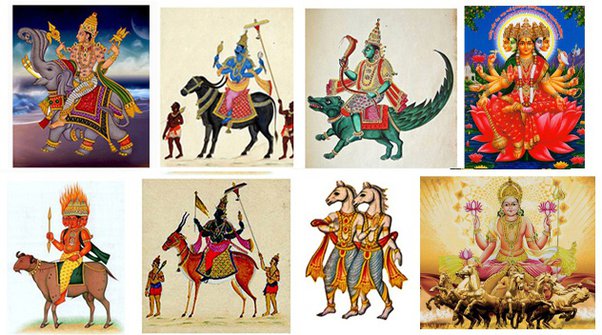|
In Vedic period, the people felt the presence of Supreme Being (Omniscient, Omnipresent & Omnipotent) presiding over the forces of nature existed in the three realms of universe and connected with the almighty by worshiping these visible forces. The importance these deities continued three yugas (Satya, Treta & Dwapar). In Dwapar yug, Kunti, wife of Pandu, conceived her sons’ using mantras of Vedic deities - Karna from Surya, Yudhishtra from Yamraja, Bhima from Vayu, Arjuna from Indra, Nakul & Sehdev from Ashvins. Even today, the worship of Vedic deities brings not only material prosperity but also spiritual enlightenment.
Internal Relevance of Vedic Deities: Sri Aurobindo, modern philosopher highlighted the relevance of each deity in the human body and the hymns dedicated to the deities (devatas). The human body is similar to the body of the Cosmic Self, Purusha, who manifested in creation as the Lord of the Universe. The Vedic deities preside over the various attributes of human body.
The cosmic manifestation is grossly divided into three worlds, the upper, lower and middle regions. In Rig Veda (Mandala 3.62.10), the highly revered mantra i.e., Gayatri Mantra is mentioned. Its recitation is traditionally preceded by Om and the formula bhur bhuvaḥ svaḥ. Om - Primeval sound; Bhur - Earth, Physical realm, Human Body; Bhuva - Antariksha, Intermediate Space, Consciousness, Prana, Vital energies; Suvah - Sky, Heaven, Soul, Spiritual realm, bliss. The Vedic Deities are classified into these three realms:
Based upon the number of invocations available in the Vedas, two other categories of the following Vedic deities were worshipped:
Characteristics of Prominent Vedic Deities:
According to the Kena Upanishad, he is the only god to have gone nearest to Brahman and was to know Him as Brahman. Humans worshipped Lord Indra as the strength until the completion of the first three ages. Till the completion of the third age (Dwapar yug), the idea of Supreme Being had been established in peoples’ minds. Lord Krishna had stopped the trend of Indra worship in his childhood and humans started a trend of worshipping Krishna in the name of Gowardhana.
Hymns of Vedic deities in Rigveda: Each hymn in Rigveda is given to a certain deity (devata) and that particular Deva is worshipped through hymns in his praise. The main deities are Indra, Agni, Soma and Surya. Each of the Gods has his consort, like Indra and Indrani, Varuna and Varunani. There are 33 Devas in Rigveda. The prominent deities are: The number of hymns in Rigveda are dedicated the Vedic deities are mentioned in bracket witnessing their importance - Indra (250), Agni (200), Soma (123), Ashvins (56), Varuna (46), Maruts (38), Mitra (28), Ushas (21), Vayu (12), Savitr (11), Rbhus (11), Pushan (10), Apris (9), Birhaspati (8), Surya (8), Dyauṣ Pitr and Pṛithvi Matr (Heaven and Earth) 6, plus 5.84 dedicated to Earth alone; Apas (6), Adityas (6), Vishnu (4 plus 2 paired hymns 1.155 dedicated to Vishnu-Indra & hymn 6.69 dedicated to Indra-Vishnu, total of 5 i.e. 4+1/2+1/2), Brahmanaspati (6), Rudra (4 plus a paired hymn 6.74 dedicated to both Soma-Rudra. A total of 41/2 i.e. 4+1/2), Dadhikras (4), Yama (4), Sarasvati (3), Parjanya (3), Vac (2), Vastospati (2), Vishvakarman (2), Manyu (2), Kapinjala (the Heathcock, a form of Indra - 2) and minor deities (one single or no dedicated hymn). Some dedications are to paired deities, such as Indra-Agni, Mitra-Varuna, and Soma-Rudra, here counted double. Visvedevas (all gods together) have been invoked 70 times. Reference:
1 Comment
P S Subramanian
6/29/2024 06:59:34 pm
Thank you for these profound informative pages.
Reply
Leave a Reply. |
Archives
May 2024
Categories |

 RSS Feed
RSS Feed